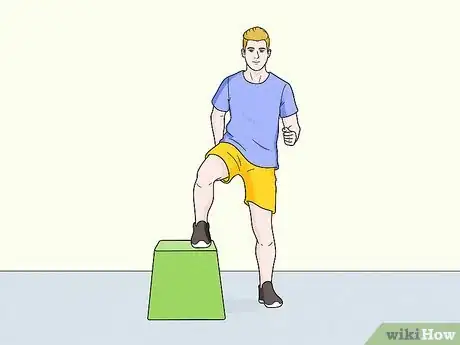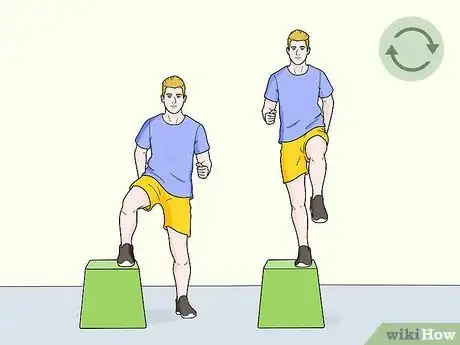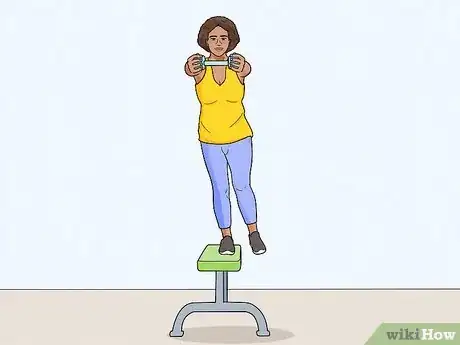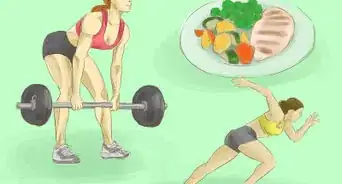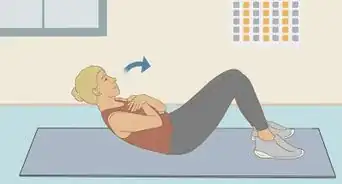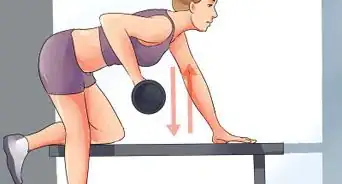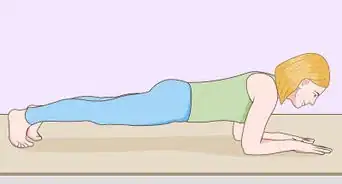This article was co-authored by Babis Kanellopoulos. Babis Kanellopoulos is a Personal Trainer and the Owner of Pod Fitness in London, UK. Babis specializes in helping clients use fitness to overcome difficulties and gain self-confidence. He has experience in kickboxing, long distance running, and martial arts. Pod Fitness sessions combine the focus of personal training with the benefits of small group, personalized, and structured training.
There are 11 references cited in this article, which can be found at the bottom of the page.
This article has been viewed 9,127 times.
If you’ve heard of the step up exercise, then you might be interested in the lateral step up. In this variation, rather than stepping straight up, you’ll step sideways onto a raised platform or bench. This trains your legs, hips, and core from a completely different direction, and can really kick your workout into high gear. Luckily, the motion for this exercise is easy to get the hang of. After getting used to it, you can add some variations to make the workout more intense.
Steps
Completing the Basic Movement
-
1Stand with an exercise bench or box on your right side. You’ll need a stable bench or box to step up onto for this exercise. Stand next to this so you’re almost touching it. This way, you’re close enough to step up.[1]
- Choosing the best bench height will depend on your fitness level. If you’re just starting out, then about 3 in (7.6 cm) off the ground, or just above your ankle, is safe to start with. If you’re in pretty good shape, then about 6–12 in (15–30 cm) should work.
- Never do this exercise if the box is unstable. You could get hurt if you slip off.
- You could also start on your left side. Just reverse the instructions.
-
2Step onto the bench with your right leg. Lift your leg, step slightly to the side, and plant your foot firmly onto the bench.[2] Keep your toes on each foot in line with each other.[3] Once you’re in a comfortable position, then shift your weight to your right foot while still keeping your left foot on the ground.[4]
- Make sure your foot is planted firmly. If it’s right on the edge of the bench, you could slip.
Advertisement -
3Lift your left leg up. Shift all of your weight to your right foot and use your core to pull your left leg up.[5] Continue lifting until your hips and shoulders are even and you’re standing tall, just with your left foot hovering in the air.
- Tighten your core as you’re lifting and lowering yourself to keep your body stable.[6]
- In some versions of the step up, you’ll actually plant your left foot on the bench along with the right one. This is a variation that you can try too.
-
4Drop your left foot back to the ground. Bend your right knee to lower your left foot smoothly.[7] Relax for a second when you reach the ground before doing more reps.
- Remember to keep your core tight as you’re dropping your leg. This keeps you balanced and stable.
- Keep your right heel planted as you’re coming down.[8] If you lift it, you could lose your balance.
- In some variations, you’ll bring your right foot back to the ground as well, then put it back up for a second rep.
-
5Repeat these movements to complete a set. Keep your right foot planted on the bench. Continue lifting and dropping your left foot, making sure to keep your core tight and stand tall.[9] Do as many repetitions as you want to complete the set.
- You can do as many as you want to, but 10 reps is a common set.
-
6Switch sides to work your other leg. Train each side equally so your body is balanced. To work the other side, simply turn around so your other leg is next to the bench. Then repeat the same motions to work that side as well.[10]
- In a standard workout, 2-3 sets on each side is the best target. If you find that too easy, you could increase the height or do more reps in a set.
Adding Variations
-
1Increase the height you’re stepping up for more of a burn. The higher the bench you use, the more of a burn you’ll feel from your step ups.[11] Try raising the bench you’re using, or stacking some strong boxes for more of a workout.[12]
- You could also use step platforms and pile them up to increase the height. You can find these at sporting goods stores or online.
- Some more intense athletes use very tall boxes almost up to their hips for step ups.[13] This is only for experienced athletes, so you'll have to work your way up to it. Stick with the same height until you can comfortably complete your routine, then increase the height slowly to step it up.
-
2Hold a dumbbell or weight to make the exercise harder. Adding some weight is a great way to turn the lateral step up into a strength-building workout.[14] Hold a dumbbell or weight on the same side that you’re lifting up during the workout. This means that if your left leg is planted on the bench, hold the weight in your right hand. Then follow the same workout steps for a lateral step up.[15]
- You don't need to hold the weight on the side that’s planted on the bench, since you won't actually be lifting from that side of your body.
- Be extra sure to keep your core tight if you’re using a weight. Otherwise, you could hurt your back.
- There’s no set weight you should start with, but pick one that you don’t have to strain to lift so you don’t pull a muscle.
-
3Try barbell step ups for a more intense strength workout. You can really kick your workout to the next level with a barbell step up. To do this, lift a barbell and hold it on the top of your back, the same way you would hold it if you were doing a squat.[16] Then go through the same motions for a strength-building step up workout.[17]
- It’s best to try this with an empty barbell first before adding any weight. Then add light plates until you find a comfortable weight.
- Remember to keep your core tight. Otherwise, your body won’t be able to support the weight as well.[18]
- Professionals don’t recommend using heavy weights for this exercise because you could easily get hurt if you slip.[19]
Expert Q&A
-
QuestionHow can I change my step ups?
 Babis KanellopoulosBabis Kanellopoulos is a Personal Trainer and the Owner of Pod Fitness in London, UK. Babis specializes in helping clients use fitness to overcome difficulties and gain self-confidence. He has experience in kickboxing, long distance running, and martial arts. Pod Fitness sessions combine the focus of personal training with the benefits of small group, personalized, and structured training.
Babis KanellopoulosBabis Kanellopoulos is a Personal Trainer and the Owner of Pod Fitness in London, UK. Babis specializes in helping clients use fitness to overcome difficulties and gain self-confidence. He has experience in kickboxing, long distance running, and martial arts. Pod Fitness sessions combine the focus of personal training with the benefits of small group, personalized, and structured training.
Personal Trainer Make your step-ups more difficult by changing the height of the step or adding weights, like dumbbells. Just make sure you've mastered the basic technique of the exercise before making it harder!
Make your step-ups more difficult by changing the height of the step or adding weights, like dumbbells. Just make sure you've mastered the basic technique of the exercise before making it harder!
Warnings
- Always test the bench or platform you’re stepping on to before doing a step up. If it collapses, you could get hurt.⧼thumbs_response⧽
- If you’re using weights during your step up routine, always start off as light as possible to avoid hurting yourself.⧼thumbs_response⧽
- Working with a spotter if you're using heavy weights is a good safety measure.⧼thumbs_response⧽
References
- ↑ https://www.uwhealth.org/exercise-fitness-aquatic/lateral-step-up/30241
- ↑ https://www.uwhealth.org/exercise-fitness-aquatic/lateral-step-up/30241
- ↑ https://youtu.be/MJTt5WZ7RYU?t=30
- ↑ Babis Kanellopoulos. Personal Trainer. Expert Interview. 6 July 2021.
- ↑ https://www.uwhealth.org/exercise-fitness-aquatic/lateral-step-up/30241
- ↑ https://youtu.be/MJTt5WZ7RYU?t=43
- ↑ https://www.uwhealth.org/exercise-fitness-aquatic/lateral-step-up/30241
- ↑ https://youtu.be/MJTt5WZ7RYU?t=25
- ↑ https://youtu.be/MJTt5WZ7RYU?t=34
- ↑ https://www.uwhealth.org/exercise-fitness-aquatic/lateral-step-up/30241
- ↑ Babis Kanellopoulos. Personal Trainer. Expert Interview. 6 July 2021.
- ↑ https://youtu.be/MJTt5WZ7RYU?t=2
- ↑ https://youtu.be/e_zx8hSKWek?t=18
- ↑ Babis Kanellopoulos. Personal Trainer. Expert Interview. 6 July 2021.
- ↑ https://youtu.be/GThrNeGcjGc?t=19
- ↑ Babis Kanellopoulos. Personal Trainer. Expert Interview. 6 July 2021.
- ↑ https://www.muscleandfitness.com/exercise/workouts/leg-exercises/barbell-lateral-step/
- ↑ Babis Kanellopoulos. Personal Trainer. Expert Interview. 6 July 2021.
- ↑ https://www.exercises.com.au/barbell-step-ups/

